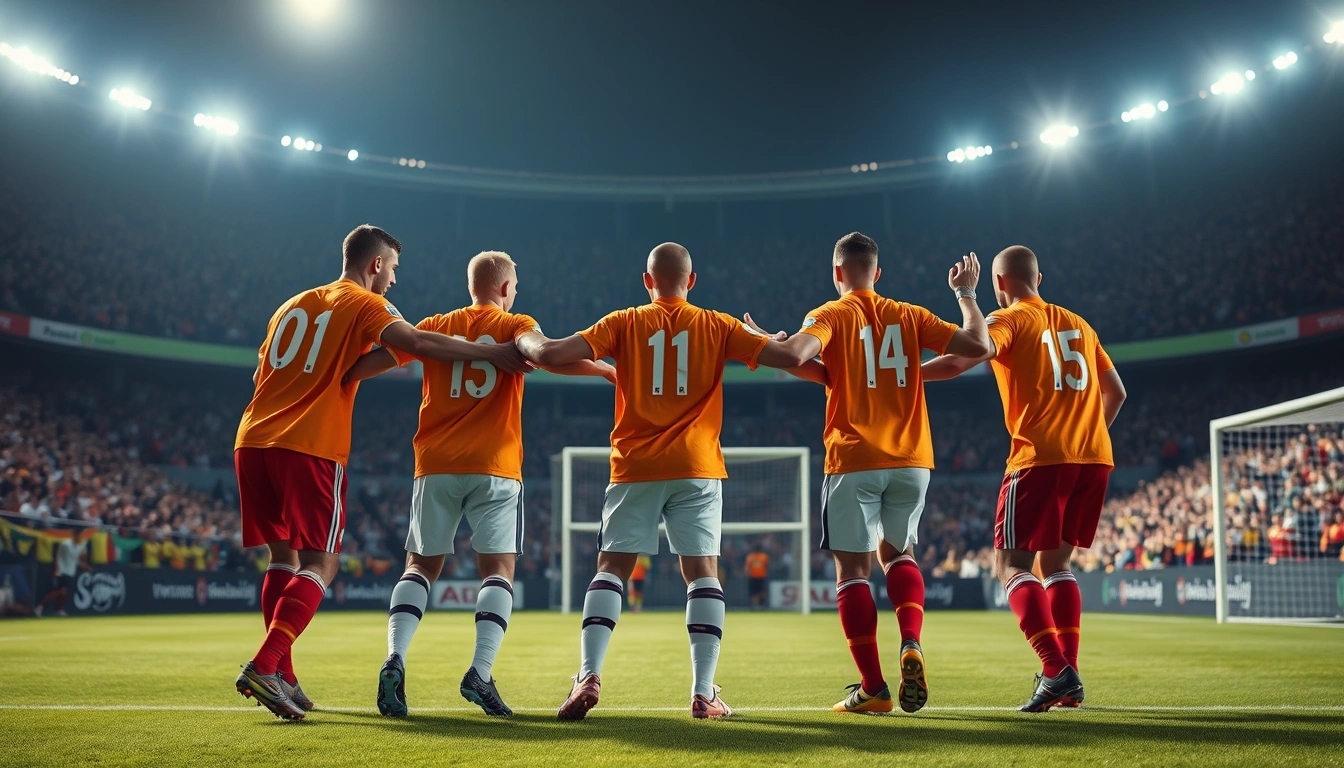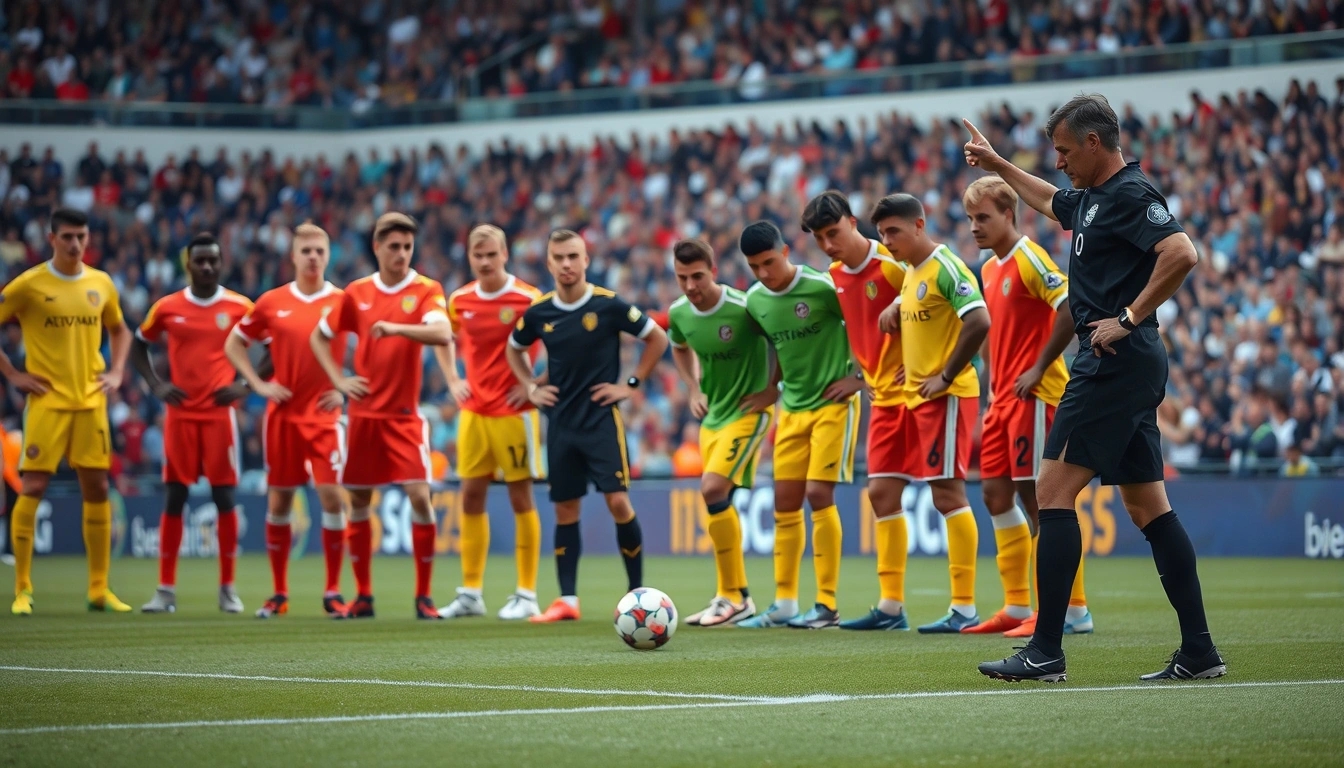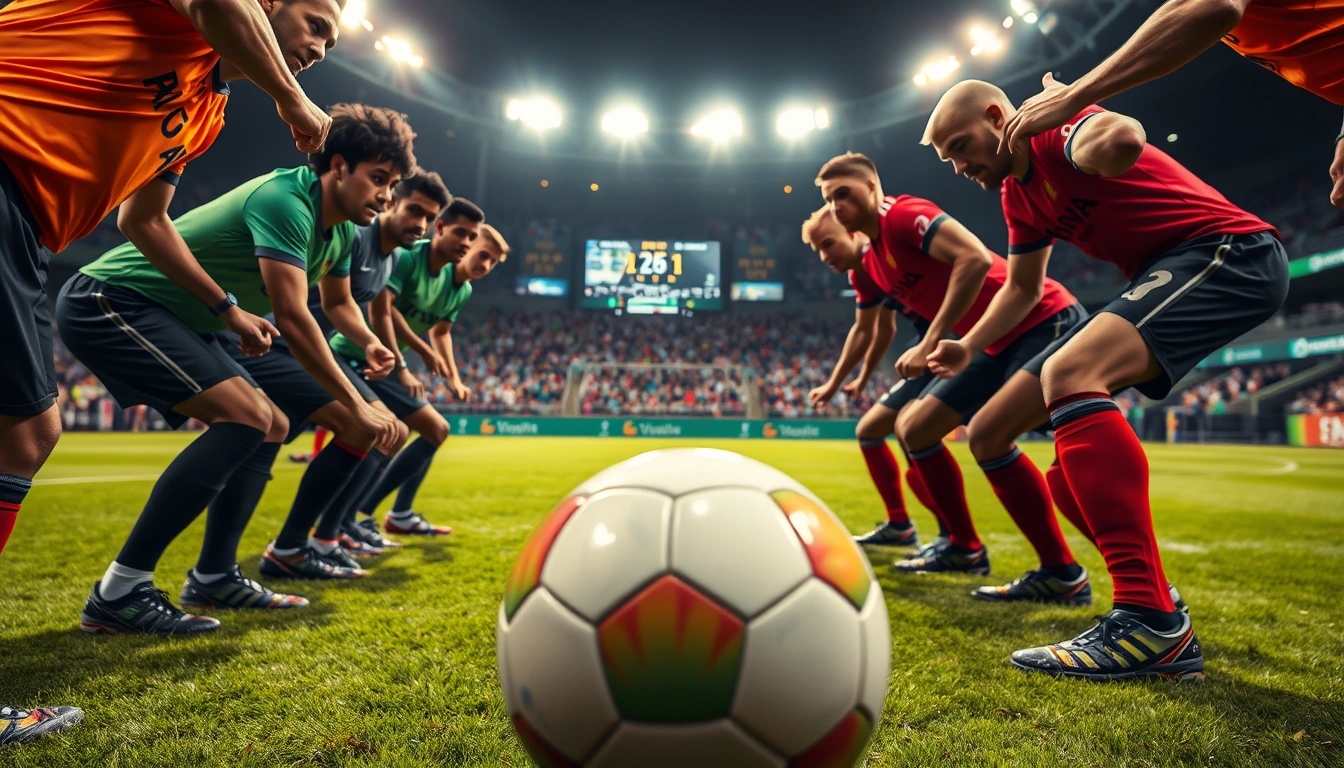Alright, so you’ve probably seen those clusters of players lining up like they’re about to pose for a group photo whenever the referee blows the whistle for a free kick. That, my friend, is what we call a free kick wall. But it’s not just some random huddle — it’s a carefully crafted defensive tactic designed to make life hell for the player about to take the shot. Let’s peel back the layers and see what’s really going on behind this classic football move.
First things first: a free kick wall is basically a bunch of defenders standing side-by-side, shoulder-to-shoulder, trying to block the most direct path to the goal. The kicker’s job? To curl, chip, or blast the ball around or over this wall and into the net. Sounds simple, right? But here’s the kicker — pun intended — the wall’s placement, size, and even the players’ stance are all part of a chess game played in seconds.
- Purpose: The wall’s main job is to reduce the target area for the shooter. By blocking the most obvious route, it forces the kicker to get creative.
- Setup: Usually, the wall stands about 10 yards (that’s roughly 9 meters) from the ball, as per the rules. The number of players varies — sometimes just three, other times up to six or seven, depending on the situation.
- Tactics: It’s not just standing still! Players might jump, lean, or shuffle to distract or block the ball better.
Now, you might wonder, “How do they decide where exactly to stand?” Well, that’s where the goalkeeper’s brain comes into play. The goalie usually directs the wall’s positioning — after all, they’re the ones who’ll have to dive to save the shot if the wall fails. They consider angles, the kicker’s preferred foot, and even the wind sometimes. The referee ensures the wall stays the legal distance away, but players are notorious for inching closer, hoping to sneak an advantage.
| Wall Size | Pros | Cons |
|---|---|---|
| Small (2-3 players) | Less chance of fouls, more agility | More gaps, easier for kicker to find space |
| Medium (4-5 players) | Balanced coverage and flexibility | Risk of miscommunication |
| Large (6+ players) | Blocks more angles, intimidating | Higher chance of fouls, less mobility |
Oh, and don’t think the wall is just about brute blocking. Some teams get downright sneaky with mind games. Players might suddenly jump as the ball is kicked, hoping to deflect it or throw off the shooter’s timing. Others might fake movements or even step out early, hoping the ref blows the whistle for a foul. It’s a psychological battle as much as a physical one.
In short, free kick walls are way more than a bunch of defenders standing still. They’re a blend of strategy, teamwork, and a pinch of gamesmanship, all aimed at stopping that perfect shot. So next time you see a wall form on the pitch, remember — it’s a small but mighty fortress in the grand chessboard of football.
The Basics: What’s a Free Kick Wall Anyway?
Alright, let’s kick things off with something pretty straightforward but surprisingly fascinating once you dig a bit deeper — the free kick wall. Picture this: a bunch of defenders huddled together, standing shoulder-to-shoulder, like an unbreakable human chain, right in front of the ball. Their main job? To block or at least make it a nightmare for the player taking the free kick to score. Sounds simple enough, right? But oh boy, there’s a lot more going on behind that wall than just standing still and hoping for the best.
First off, this “wall” isn’t just a random group of players thrown together. It’s a carefully chosen squad, usually the tallest and most alert defenders, sometimes even midfielders, who can jump, react, and cover as much space as possible. The idea is to cover a portion of the goal that the goalkeeper can’t easily reach, forcing the kicker to either curl the ball around the wall or blast it over — both tricky shots under pressure.
- Why a wall? Because the free kick is a direct shot opportunity — no defenders allowed within 10 yards of the ball until it’s kicked. So, the wall is the only line of defense standing between the shooter and the goal.
- How many players? Usually between 3 to 5, but sometimes coaches throw in 6 or 7 if the situation is desperate. Too many, though, and it gets cramped, leading to gaps or even fouls.
Now, here’s a fun twist: the wall isn’t just a static barrier. Players in the wall can jump to block high shots or even lean to one side to create a gap, tricking the kicker into aiming where there’s suddenly no one. Sometimes the wall moves just a little at the last second — a sneaky tactic to mess with the shooter’s timing. And yes, referees keep a hawk eye to make sure defenders don’t step forward early or move illegally.
| Aspect | Details |
|---|---|
| Positioning | Usually 9-10 yards from the ball, aligned to cover the near post side |
| Players | 3-5 typical; varies by situation |
| Goalkeeper Role | Directs wall placement, covers goal areas not protected by wall |
| Common Tactics | Jumping, leaning, timed movements to confuse kicker |
So yeah, while the free kick wall might look like a simple defensive tactic, it’s actually a mini chess game played in seconds. The kicker studies the wall, the wall tries to predict the kicker’s shot, and the goalie calls the shots from behind. It’s a blend of skill, strategy, and a pinch of luck. Next time you see a free kick, watch that wall closely — there’s a lot more drama packed in those few seconds than you’d think!
Positioning: Where Do They Stand and Why?
Ever caught yourself squinting at a free kick, wondering how on earth the defenders decide where to plant that wall? Believe me, it’s not just a random huddle thrown together in panic. There’s a whole method to this madness, and it’s a mix of geometry, psychology, and a dash of referee timing that can make or break a team’s defense.
First off, the distance from the ball to the goal is crucial. Too close, and the wall has to be tight and compact to cover the immediate danger zone. Too far, and the wall can spread out a bit more, covering angles and forcing the kicker to think twice before aiming for the corners. It’s a bit like setting up a chessboard, where every inch matters.
| Distance from Ball | Wall Setup | Purpose |
|---|---|---|
| Less than 20 yards | Compact, 3-4 players | Block direct shots, reduce reaction time |
| 20-30 yards | Spread out, 4-6 players | Cover angles, force kicker to curve ball |
| More than 30 yards | Flexible, 5+ players | Cover goal width, anticipate passes |
Then, there’s the angle. Players position themselves based on where the ball is relative to the goalposts. The wall usually covers the side the goalkeeper can’t reach easily, while the goalie guards the other side. It’s a bit like a tag team — both working together but with their own zones.
- Closer to the corner flag? The wall shifts to cover the near post.
- Central spot? The wall centers up, blocking the middle.
- Wide angle? The wall might be smaller, focusing on blocking direct shots.
Now, here’s where it gets spicy: the referee’s whistle. The wall can’t just jump the gun and move forward before the ball is kicked, or else it’s a free shot for the other team. But players are sneaky—sometimes they inch forward the moment the ref’s about to blow, hoping to catch the kicker off guard. It’s a game of timing, nerves, and sometimes, blatant cheekiness.
Oh, and don’t forget the goalkeeper’s role in all this. While the wall is busy blocking, the goalie is constantly shouting instructions, adjusting the wall’s position, and ready to dive if the ball sneaks past. It’s like a conductor leading an orchestra, making sure every note hits perfectly.
Tips for Wall Positioning:- Always watch the kicker’s stance and preferred foot.- Communicate constantly between goalie and defenders.- Adjust quickly if the kicker changes position.- Stay alert for fake runs or sudden shifts.
In short, setting up a free kick wall isn’t just about standing still and hoping for the best. It’s a calculated dance of positioning, timing, and a bit of mind games. Next time you see that wall line up, you’ll know there’s a whole strategy behind those shoulder-to-shoulder defenders — and maybe, just maybe, a little bit of magic too.

Wall Size: How Many Players Should Be There?
When it comes to free kick walls, the age-old question pops up: how many players should you cram into that tight little lineup? Too few, and honestly, you might as well invite the kicker to a buffet—wide open goal, no pressure. But pack the wall too tight, and suddenly you’re juggling fouls, gaps, and the occasional player tripping over their own feet. It’s a delicate dance, really.
First off, there’s no magic number that fits every scenario. Usually, teams settle somewhere between three to five players. Three might feel a bit light, but it’s often enough when the free kick is from a tricky angle or distance. Five? That’s your heavy-duty wall, usually for those screaming shots from right in front of the goal. But beware, stuffing more than five can cause chaos—players bumping into each other, referees waving their whistles for encroachment, and the kicker getting a free pass through unexpected gaps.
| Number of Players | When to Use | Risks |
|---|---|---|
| 3 | Long distance or tight angles | Less coverage, more room to shoot |
| 4 | Moderate distance and angle | Balanced coverage, but watch spacing |
| 5+ | Close range, direct shots | Fouls, gaps, and player confusion |
Now, let’s get real—sometimes, the wall size isn’t just about numbers but also about the players’ height and jumping ability. Taller defenders can cover more vertical space, so fewer might be needed. Meanwhile, a wall full of shorties? You’d better pack more bodies in there or risk a rocket sailing over everyone’s heads.
- Height matters: Taller players fewer needed
- Jump timing: Coordinated jumps can block even the sneakiest shots
- Communication: Players must know when to jump or shift
And let’s not forget the referee’s role. The infamous “10-yard” rule means the wall must be placed exactly 10 yards from the ball. If the wall creeps closer, you’re looking at a free kick retake or even a yellow card for the defenders. So, packing a wall with too many players risks stepping on the ref’s toes, literally.
Here’s a quick rundown of the chaos that can happen when walls get too crowded:
- Players bump into each other, losing balance- Gaps form as defenders try to avoid contact- Increased chance of fouls and free kick retakes- Confusion about when to jump or stay still
So what’s the takeaway? The perfect wall size isn’t just about numbers—it’s a mix of player attributes, the kick’s angle, and a sprinkle of referee tolerance. Coaches who nail this balance often save crucial goals, while those who don’t might as well hand the ball over on a silver platter.
In the end, it’s a bit of an art and a bit of a headache. But hey, that’s football for you—never a dull moment, especially when you’re trying to build a wall that actually walls something up!
Goalkeeper’s Role: Not Just a Bystander
Alright, let’s get one thing straight: the goalkeeper isn’t just standing there looking pretty behind the wall during a free kick. Nope, they’re the command center of that defensive fortress, and honestly, without their input, the whole setup could fall apart faster than you can say “goal.”
First off, the goalie has the best vantage point on the pitch. From their spot, they can see the kicker, the wall, the angle, and the positioning of every single defender. This eagle-eye view means they’re the ones shouting instructions like a coach on steroids, telling defenders exactly where to plant their feet, how high to jump, and when to duck. It’s not just about standing shoulder-to-shoulder; it’s about creating a human barrier that’s as frustrating as a mosquito buzzing in your ear.
Now, you might think the referee decides where the wall goes, but actually, the goalie has a massive say in that. They’re the ones deciding the sweet spot for the wall — close enough to block the shot but not so close that it blocks their own view. It’s a delicate balance, kind of like trying to squeeze into your jeans after Thanksgiving dinner. The wall’s placement is tactical, and the goalie’s voice is usually the loudest in the huddle.
| Goalkeeper’s Responsibilities | Why It Matters |
|---|---|
| Directing wall placement | Ensures optimal blocking angle and visibility |
| Communicating with defenders | Coordinates timing of jumps and movements |
| Reading kicker’s body language | Predicts shot direction and prepares to dive |
| Adjusting positioning during the kick | Maintains clear sightlines and reaction readiness |
Let’s not forget that goalies also have to read the kicker’s mind, or at least try to. They watch the run-up, the angle of the foot, the body lean—anything that might hint where the ball’s gonna fly. It’s like a high-stakes poker game, with the goalie trying to guess the kicker’s next move before the ball leaves the boot. Spoiler alert: sometimes they get it wrong, but hey, nobody’s perfect.
- Pro tip: Goalkeepers often practice with their wall defenders to develop a rhythm for jumping or ducking at the right moment.
- Fun fact: Some goalkeepers have been known to shout random, distracting things at the kicker to throw them off their game.
And yeah, while the wall might steal the spotlight (or the ball), the goalie’s role is the glue holding it all together. They’re the strategist, the motivator, and the last line of defense all rolled into one. So next time you see a free kick, remember: that goalie isn’t just chilling behind the wall—they’re running the show.
Common Tactics: Tricks Behind the Wall
Alright, let’s get real about free kick walls. You might think these guys just stand there, looking all serious and blocking shots like statues. But nah, it’s way more than that. Football teams have cooked up a whole bag of sneaky tricks to mess with the kicker’s head — and if you thought it’s just about “stand still and block,” you’re in for a surprise.
First off, there’s the classic fake jump. You know, when the wall suddenly leaps up like they’ve seen a ghost? It’s not just for show; it’s to throw off the timing of the shot. Kickers rely on rhythm and timing, so a well-timed jump can make them screw up their shot or hit the ball too early or late. But here’s the kicker (pun intended): sometimes the wall will jump too soon, or not at all, just to keep the kicker guessing. It’s like a mind game on steroids.
- Fake moves: Players might shuffle side to side, stretch a leg out, or even look away, hoping to distract the kicker.
- Sudden jumps: The wall might leap as the ball is kicked, hoping to block the shot mid-air.
- Changing wall size: Sometimes defenders sneak in or out of the wall at the last second to confuse the kicker about how many players they’re up against.
Now, don’t underestimate the role of psychology here. The kicker is under pressure, the crowd is roaring, and the wall is staring at them like a brick wall (pun also intended). Teams use this tension to their advantage. For example, defenders might start chatting loudly, waving their arms, or even shouting instructions to mess with the kicker’s concentration.
| Tactic | Purpose | Effect on Kicker |
|---|---|---|
| Fake Jump | Disrupt kicker’s timing | Kicker may shoot too early or late |
| Wall Size Change | Confuse kicker about blocking coverage | Uncertainty leads to poor shot placement |
| Distracting Movements | Break kicker’s focus | Increased chance of error |
Oh, and here’s a juicy tidbit: sometimes the wall’s positioning itself isn’t just about blocking the ball, but also about trapping the kicker into a predictable shot. By closing certain angles and leaving others “open,” they funnel the shot where the goalkeeper is ready to pounce. It’s like chess, but with sweaty players and a ball.
So, next time you watch a free kick, don’t just focus on the kicker — watch the wall. Those defenders are up to all sorts of mischief. They’re not just standing there looking pretty; they’re playing mind games, using timing tricks, and trying to psych out the opposition. It’s a wild mix of strategy, nerves, and sometimes pure luck.
Practical tip for newbies: If you ever find yourself in a wall, don’t just freeze. Move a little, keep your eyes on the ball, and be ready to jump at the right moment. And maybe, just maybe, throw in a fake jump or two to mess with the kicker’s head. After all, in football, it’s not just about muscle — it’s about the mind.
In summary:
- Walls use fake jumps and movements to disrupt timing.
- Changing the number of players last second adds confusion.
- Distracting the kicker is a legit tactic, not just annoying behavior.
- The wall’s positioning can force the kicker into making predictable choices.
So yeah, free kick walls are like the sneaky ninjas of football defense — silent, strategic, and ready to mess with your head when you least expect it.

Rules and Regulations: What’s Allowed and What’s Not?
Alright, let’s cut to the chase — free kick walls might look like a simple bunch of players standing in a line, but there’s a whole rulebook behind that seemingly innocent setup. You’d think it’s just “stand here, block the shot,” but nope, the laws governing walls are packed with nuance, referee quirks, and yes, that infamous “10-yard” rule everyone loves to debate.
First off, the 10-yard distance is the cornerstone of free kick walls. According to the Laws of the Game, the attacking team’s wall must be at least 10 yards (roughly 9.15 meters) away from the ball when the kick is taken. This isn’t just a random number plucked out of thin air — it’s designed to give the kicker a fair chance while preventing defenders from crowding and blocking shots unfairly. But here’s the kicker: referees have some wiggle room. Sometimes they let walls creep in a yard or two, especially if the defense is quick to set up or the ref is distracted. And if the wall jumps forward early? That’s a foul, and the kicker gets a retake. Simple, right? Well, not always.
| Rule | What It Means | Common Referee Calls |
|---|---|---|
| 10-Yard Distance | Wall must be at least 10 yards from the ball | Often ignored slightly; ref discretion varies |
| Jumping or Moving Early | Defenders can’t jump or move before the kick | Foul called, kick retaken |
| Wall Size Limit | No official max, but practical limits apply | Too many players can lead to encroachment calls |
Now, about the wall size — there’s no official cap on how many defenders you can stuff in there, but piling on too many can backfire. Referees might blow the whistle for encroachment or obstruction, especially if the wall blocks the goalkeeper’s view or restricts the kicker’s movement unfairly. It’s a fine line between “solid defense” and “illegal blockade.”
And speaking of referees, their role isn’t just to enforce the rules but to interpret them on the fly — sometimes with a bit of personal flair. You’ll see some refs who are sticklers for the 10-yard rule, while others might let things slide if the attacking team doesn’t complain. It’s a bit of a cat-and-mouse game, and players know it. You’ll often see defenders inching closer inch by inch, daring the ref to call them out. Sneaky, huh?
- Encroachment: When defenders cross the 10-yard line early, the kick is retaken or advantage given.
- Obstruction: Blocking the goalkeeper’s line of sight can be penalized.
- Fouls on the kicker: Defenders must not interfere physically with the kicker.
In practice, these rules create a chess match between the attacking side trying to find a gap and the defense trying to close it down without stepping on the referee’s toes. It’s part skill, part nerves, and part luck.
So next time you see a wall form up, remember it’s not just a bunch of players standing still. It’s a carefully choreographed defense dance, with refs playing the role of the sometimes grumpy choreographer. And yes, that “10-yard” rule? It’s the star of the show — even if it sometimes feels like everyone’s just guessing where that line really is.
Quick Tip for Beginners:
- Always check the referee’s positioning before setting the wall.- Make sure your wall respects the 10-yard distance — no creeping!- Watch the kicker’s run-up and be ready to jump at the right moment.- Communicate constantly to avoid accidental fouls or encroachment.
In the end, understanding these rules isn’t just for refs or pros — it’s for anyone who wants to truly appreciate the beautiful complexity behind that “simple” wall.
Famous Free Kick Walls in Football History
Some free kick walls have gone down in football folklore, not just for holding firm but for the downright bizarre and unforgettable moments they’ve sparked. I mean, let’s be honest, walls are usually these serious, tight-knit groups of defenders, but every now and then, things get a little… chaotic. You know, the kind of chaos that makes you laugh, cringe, or just shake your head wondering, “Did that really just happen?”
- The Berlin Wall (2014 World Cup): Okay, not the actual Berlin Wall, but Germany’s defensive line in the semi-final against Brazil was so solid, it felt like you’d need a wrecking ball to get through. Their wall was perfectly positioned, disciplined, and basically said, “No free kick goals today, thanks.” Brazil’s attempts were stifled, and the rest is history – a crushing 7-1 defeat that no one saw coming.
- Argentina’s Wall of Confusion (Messi Era): Messi’s Argentina has had its share of free kick drama. Sometimes, their wall looks like a perfectly choreographed dance, while other times, players just seem to forget where to stand, leaving gaps wide open. Remember that Euro-style free kick by Messi against Nigeria in the 2018 World Cup? The wall barely moved, and that ball curled in like magic.
- That Legendary Fail: The 2010 Chelsea Wall: Chelsea’s wall once became the punchline of a viral clip where players literally forgot to jump together, letting a free kick sail right over their heads. The goalkeeper’s face? Priceless. It’s a reminder that even the best teams can have their “what was that?” moments.
| Match | Team | Moment | Outcome |
|---|---|---|---|
| 2014 World Cup Semi-Final | Germany | Impenetrable wall against Brazil | 7-1 victory, historic defensive display |
| 2018 World Cup Group Stage | Argentina | Messi’s curling free kick vs Nigeria | Goal, wall failed to block |
| 2010 Premier League | Chelsea | Wall failed to jump, free kick sailed over | Goal conceded, viral fail clip |
Now, don’t get me wrong, walls aren’t just about standing still and looking intimidating. There’s a whole psychology game behind them. Some teams try to mess with the kicker’s head by shifting positions, pretending to jump early, or even having players sneak behind the wall to catch the shooter off guard. It’s like a mini chess match every time the ball’s set on the spot.
Here’s a quick rundown of why some walls become legendary (or infamous):
- Perfect Timing – Jumping at the right moment can block a shot or force the kicker to alter their strike.
- Communication – Goalkeepers shouting orders, defenders adjusting on the fly.
- Physical Presence – Taller, bigger players can intimidate and physically block more space.
- Coordination – A wall that moves as one unit is far more effective than a bunch of individuals just standing there.
In the end, free kick walls are a mix of art, science, and sometimes, pure luck. They’ve given us some of football’s most jaw-dropping moments, whether it’s a perfect block or a hilarious blunder. Next time you watch a free kick, pay attention to that wall – it might just steal the show.
Practical Tip: If you ever find yourself organizing a wall (hey, maybe at a Sunday league game), remember this: it’s not just about the number of players but how well you work together. Communicate, time your jumps, and for goodness’ sake, don’t forget to actually jump!
So yeah, free kick walls might seem like a simple defensive tactic, but history shows they can be legendary for all sorts of reasons – glory, disaster, or just pure entertainment.
Practical Tips for Beginners: Building Your Own Wall
Alright, so you’re either coaching a bunch of eager newbies or just plain curious about how to put together a free kick wall that actually does its job — and not just stand there looking like a bunch of confused tourists. Setting up a wall might seem straightforward: line up some players, cross your fingers, and hope for the best. But trust me, there’s more finesse to it than meets the eye.
First things first, communication is your best friend. If the goalkeeper hasn’t shouted out clear instructions, or if the players don’t know their roles, expect chaos. Walls can quickly turn into a comedy show if players start pushing, shoving, or worse, turning their backs to the ball. Nobody wants that.
| Step | What to Do | Why It Matters |
|---|---|---|
| 1 | Determine wall size based on distance and angle | Too few players big gaps; too many risk of fouls |
| 2 | Position players shoulder-to-shoulder | Blocks the shot effectively, no gaps |
| 3 | Assign roles (jump, duck, or stay still) | Confuses the kicker and covers different shot heights |
| 4 | Goalkeeper directs the wall’s placement | Optimizes blocking angles and covers weak spots |
| 5 | Practice timing with the referee’s whistle | Prevents early movement fouls and ensures readiness |
Now, here’s a nugget of wisdom: don’t just cram your tallest players into the wall. While height helps, agility and timing can be just as important. If everyone’s stiff as a board, the kicker will eat you alive with low shots or clever curves. Mix it up! Some players should be ready to jump, others to duck, and a few to stay grounded and block low attempts.
Also, practice makes perfect, but keep it fun. Walls can get boring if you just tell players to “stand here and block.” Instead, throw in some drills where they anticipate the kick, shift quickly, or even try to fake out the kicker with sudden movements. You’ll see their focus sharpen and, honestly, it’s a lot less likely they’ll start giggling or zoning out.
- Tip #1: Mark the spot on the field where the wall should stand — use cones or chalk. This helps players find their position quickly.
- Tip #2: Remind players to keep their arms close to their bodies to avoid unnecessary fouls.
- Tip #3: Encourage eye contact between wall members and the goalkeeper for quick adjustments.
One last thing — walls aren’t just about brute force. It’s a mental game too. Players who can stay calm, communicate, and adjust on the fly make all the difference. Don’t expect perfection right away. Walls can look a bit messy in the beginning, but with patience and practice, they’ll become a fortress.
So, if you’re gearing up for your next match or just want to impress your mates with some defensive know-how, keep this checklist handy and remember: it’s all about teamwork, timing, and a bit of cheeky strategy. Now, go build that wall — but maybe skip the comedy acts!

Why Walls Still Matter in the Age of Technology
So, here we are in 2024, where every inch of football is dissected by high-tech gizmos, video replays, and stats that could make your head spin. You’d think the humble free kick wall—those bunches of defenders huddled together like a human barricade—would be as outdated as dial-up internet. But nope, these walls are still very much alive and kicking (pun intended) on the pitch. Let’s dive into why this old-school defense tactic refuses to fade away despite all the tech wizardry.
First off, the wall is a physical barrier that no amount of fancy analytics can replace. Sure, data might tell you the shooter’s preferred angle or the probability of curling the ball around the wall, but when the ball is flying at 70 mph, it’s the defenders’ bodies that count. It’s like trying to block a bullet with a spreadsheet—just doesn’t work. The wall forces the kicker to adjust their shot, often pushing them into riskier attempts or less optimal angles.
| Advantages of Free Kick Walls | Limitations of Technology Alone |
|---|---|
| Physical obstruction of shot | Cannot physically block ball |
| Psychological pressure on kicker | Data can’t intimidate |
| Forces shot adjustments | Prediction isn’t prevention |
| Quick, adaptable positioning | Delayed decisions from video analysis |
Now, don’t get me wrong—video replays and analytics are game changers. Coaches pore over heat maps, player tendencies, and even wind conditions before setting up their defenses. But when the whistle blows, it all boils down to split-second reactions and muscle memory. The wall’s placement is often a mix of experience, instinct, and yes, a bit of guesswork. Sometimes you see walls jumping just as the ball is struck—classic mind games to throw off the shooter’s rhythm. Technology can’t replicate that human element.
- Psychological Warfare: The wall’s presence can rattle even the most confident free kick takers.
- Adaptability: Walls can shift, crouch, or leap based on the situation, something no AI can do instantly.
- Team Coordination: It’s a collective effort, showcasing real-time communication between goalkeeper and defenders.
Plus, let’s talk about the rules. The infamous “10-yard” distance that attackers must keep from the wall is still enforced by referees, sometimes with a sprinkle of controversy. Video technology helps spot infringements, but the wall’s effectiveness also depends on these regulations being respected. It’s a dance of law enforcement and physical presence.
In the end, while tech provides the roadmap, the free kick wall remains the last line of defense that technology alone can’t replace. It’s a reminder that football, at its core, is as much about human grit and unpredictability as it is about stats and screens. So next time you see a wall standing firm, remember: it’s not just a relic of the past, but a vital piece of the beautiful game’s defensive puzzle.
Practical Tips for Appreciating Walls Today:- Watch how goalkeepers direct the wall; it’s a strategic command post.- Notice the timing of jumps or shifts—these are rehearsed mind games.- Remember that walls can be a psychological hurdle, not just a physical one.
In summary: Walls are far from obsolete. They blend tradition with tactical savvy and human instinct, proving that some things in football just can’t be digitized away.
Frequently Asked Questions
- What exactly is a free kick wall in football?
Think of a free kick wall as a human shield made up of defenders standing side-by-side to block a direct shot on goal. It’s like a mini fortress aimed at making it tougher for the kicker to score. Simple, yet super effective!
- How do players decide where to position the wall?
Positioning is a clever mix of art and science. Players consider the distance from the ball, the angle to the goal, and even referee signals. It’s like setting up dominoes—one wrong move, and the whole strategy falls apart.
- How many players should be in a free kick wall?
There’s no magic number, but usually between three to five defenders form the wall. Too few, and the goal looks like an open buffet; too many, and you risk fouls or gaps. It’s a delicate balance, kind of like seasoning a dish.
- What role does the goalkeeper play in setting up the wall?
Goalkeepers aren’t just watching from the sidelines—they’re the wall’s mastermind. They direct where it should stand to cover the most dangerous angles, acting like a chess player anticipating the opponent’s next move.
- Are there any sneaky tactics teams use with free kick walls?
Absolutely! Walls aren’t just static barriers. Players might jump suddenly, shuffle, or even fake moves to throw off the kicker’s timing. It’s a psychological game, like a magician distracting you before the big trick.
- What are the rules governing free kick walls?
The key rule is the “10-yard” distance—the wall must stay at least 10 yards from the ball until it’s kicked. Moving too early or blocking illegally can earn fouls or free kicks the other way. Referees keep a sharp eye on this delicate dance.
- Can you give examples of famous free kick walls in football history?
Some walls have gone down in history for heroic blocks or hilarious blunders. Think of legendary matches where walls either saved the day or turned into comedic gold—proof that this defensive tactic can be thrilling and unpredictable.
- How can beginners build an effective free kick wall?
Start with clear communication and positioning. Make sure everyone knows their role, stand close but avoid fouls, and practice timing your jumps. It’s like building a team fortress—strong, coordinated, and ready to defend.
- Do free kick walls still matter with modern technology and analytics?
Even with video replays and fancy stats, walls remain a vital defense tool. They add a human element that tech can’t replace—real-time reactions, teamwork, and unpredictability. Walls keep the spirit and drama of football alive!











